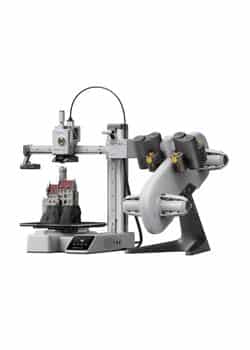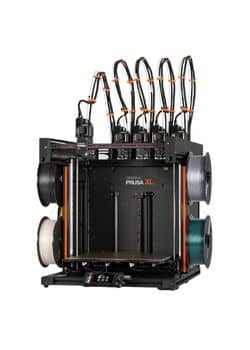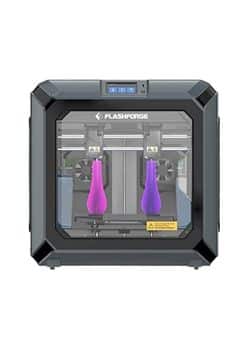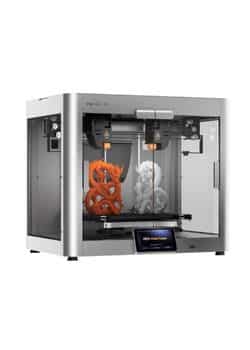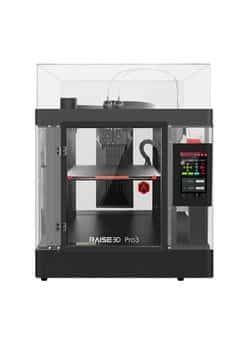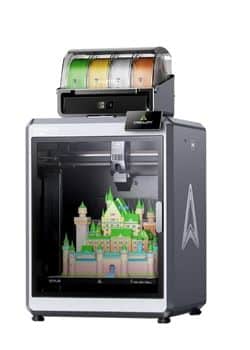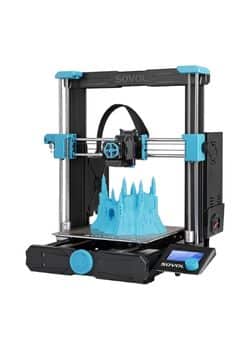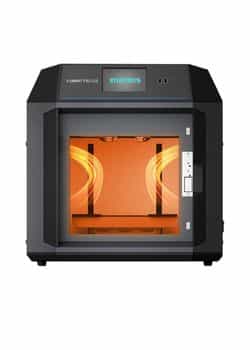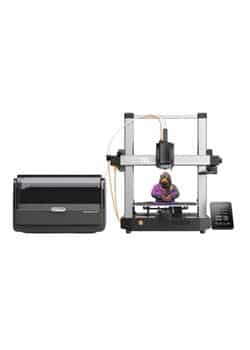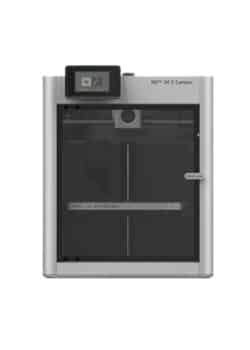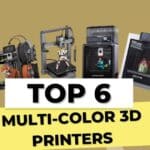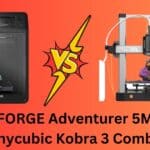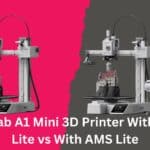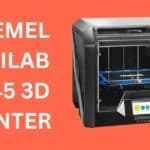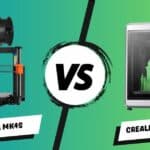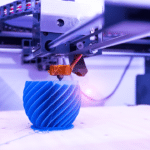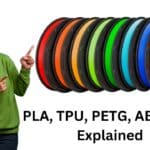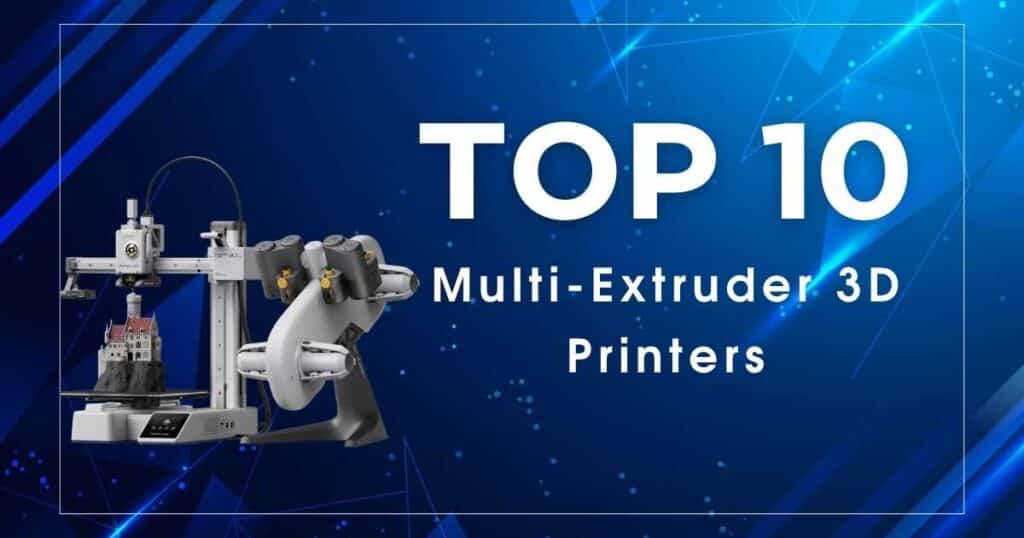
So, you’ve mastered the single-color print. You’ve got a shelf full of pristine white models and a growing itch to make something more—something vibrant, complex, and truly eye-catching. That’s where multi-extruder printers come in. These aren’t the finicky, expensive machines of yesteryear. In 2025, they’re smarter, faster, and more accessible than ever, ready to turn your monochrome dreams into full-color reality.
Affiliate Disclosure
We participate in Amazon affiliate programs, earning fees from qualifying purchases via links at no extra cost to you. It’s how we keep this blog rolling and my 3D printers buzzing with fresh filament for reviews like this one!
Whether you’re a cosplayer crafting a helmet with integrated transparent visors, an engineer prototyping a part with rigid and flexible components, or a hobbyist who just wants to print a dazzling, multi-colored figurine in one go, there’s a machine on this list for you.
We’ve combed through specs, pored over user reviews, and tested these printers to bring you a curated list of the best. Let’s dive in and find the tool that will unlock your next creative level.
First, a quick primer: For a deep dive into the filaments these machines can use, from PLA to PEEK, our Filament Compatibility Guide is an essential read.
Why Go Multi-Material? It’s More Than Just Color.
Sure, printing in four colors is incredibly cool. But the benefits of a multi-extruder system run much deeper:
- Soluble Supports: This is a game-changer. Print your model in PLA and the support structures in PVA or BVOH. When the print is done, you drop it in water, and the supports dissolve away, leaving a perfectly smooth, complex surface that would be impossible to clean with traditional supports.
- Material Hybrids: Imagine a drone propeller with a rigid PLA core and a flexible TPU tip to absorb impact. Or a tool handle with a hard interior and a soft, grippy exterior. Multi-extruder printers make this possible in a single print job.
- Efficiency and Reliability: No more babysitting your printer to manually swap filaments at a specific layer, a process prone to failure and misalignment. The machine handles it all automatically.
Modern systems, especially IDEX (Independent Dual EXtruder) models, have largely solved the old problems of oozing and stringing, making the process remarkably clean and reliable.
How We Picked: Real People, Real Prints
Our list isn’t just based on spec sheets. We prioritized:
- User Experience: How easy is it to go from unboxing to a successful multi-color print?
- Community & Support: Is there a helpful user base? Does the manufacturer stand behind their product?
- Value: Does the performance justify the price tag?
- Reliability: Does it produce great results consistently, or is it a constant project?
Now, let’s meet the contenders.
The Top 10 Multi-Extruder 3D Printers of 2025
1. Bambu Lab A1 Mini with AMS Lite
The Joyful Gateway to Color Printing
The A1 Mini is the printer that made multi-color printing accessible to the masses. It’s not the biggest or the absolute fastest, but it might be the most fun. The entire experience—from unboxing to your first rainbow print—is polished, intuitive, and surprisingly affordable. The AMS Lite automatically manages four filaments, swapping them with a quiet, satisfying precision that feels like magic.
Key Specs:
- Build Volume: 180 x 180 x 180 mm
- Print Speed: Up to 500 mm/s
- System: AMS Lite (4 materials via single hotend)
- Price: $599.00
The Good:
✅ Unbelievably user-friendly; the gold standard for beginners.
✅ Compact and surprisingly quiet.
✅ Vibrant, active community and excellent software.
✅ Exceptional value for the feature set.
The Not-So-Good:
❌ The small build volume limits larger projects.
❌ Best with PLA/PETG; not for high-temp materials.
❌ The print bed is proprietary (but flexible and effective).
The Verdict: “I was printing flawless multi-color models on day one without any prior experience. It just works.” – A thrilled new user.
Best for: Beginners, hobbyists with limited space, and anyone who wants a hassle-free entry into color printing.
2. Original Prusa XL (5-Toolhead)
The Uncompromising Professional’s Powerhouse
The Prusa XL takes a radically different approach: a tool-changer. Instead of one hotend handling multiple filaments, it has up to five complete, independent toolheads that dock with robotic precision. This means each material is always at the perfect temperature, eliminating oozing and stringing entirely. It’s a beast designed for flawless, large-format, multi-material production where failure is not an option.
Key Specs:
- Build Volume: 360 x 360 x 360 mm
- Print Speed: Up to 250 mm/s (focused on impeccable quality)
- System: Tool-Changer (5 independent toolheads)
- Price: $4,799.00
The Good:
✅ Unmatched print quality and reliability for professional use.
✅ Zero waste and zero cross-contamination between materials.
✅ Massive, cubic build volume.
✅ Expandable and backed by Prusa’s legendary support.
The Not-So-Good:
❌ A significant investment for professionals only.
❌ Large physical footprint.
❌ The learning curve is steeper than more automated systems.
The Verdict: “It’s the printer you buy when you’re done fiddling and just need perfect, complex parts to come out, every single time.” – A product design professional.
Best for: Engineering firms, professional designers, and makerspaces that need the ultimate in precision and material flexibility.
3. Flashforge Creator 3 Pro
The Industrial Workhorse for the Serious Maker
The Creator 3 Pro is a stalwart in the IDEX space. It feels industrial—a fully enclosed, solidly built machine that means business. Its independent dual extruders allow for classic dual-color printing, mirror mode (printing two identical copies at once), and duplication mode. It’s a incredibly capable and reliable machine that excels with engineering-grade filaments thanks to its heated chamber.
Key Specs:
- Build Volume: 300 x 250 x 200 mm
- Print Speed: Up to 120 mm/s (reliable and consistent)
- System: IDEX (Independent Dual Extruders)
- Price: $2,656.00
The Good:
✅ Fully enclosed and heated chamber for ABS, Nylon, and more.
✅ Authentic IDEX functionality with minimal oozing.
✅ Extremely sturdy and reliable construction.
✅ Excellent software and connectivity options.
The Not-So-Good:
❌ Print speed is conservative compared to modern speedsters.
❌ The slicing software has a learning curve.
❌ Higher price point for its core feature set.
The Verdict: “This is my go-to for printing functional parts in ABS and nylon. It’s a tank that doesn’t fail.” – An engineering student.
Best for: Makers and professionals who need a reliable, enclosed IDEX printer for technical filaments.
4. Snapmaker J1s
The All-In-One Wonder for the Renaissance Maker
Why have one tool when you can have three? The Snapmaker J1s is a unique proposition: a high-speed IDEX 3D printer, a CNC carver, and a laser engraver, all in one sleek package. If your creativity spans different mediums, this machine eliminates the need for multiple dedicated tools. It’s beautifully designed and surprisingly capable in all three modes.
Key Specs:
- Build Volume: 300 x 200 x 200 mm (Single), 160 x 200 x 200 mm (Dual IDEX)
- Print Speed: Up to 350 mm/s
- System: IDEX + CNC + Laser
- Price: $599.00
The Good:
✅ Unbeatable versatility in a single footprint.
✅ High-speed printing performance.
✅ Elegant design and intuitive software.
✅ Toolhead swapping is quick and easy.
The Not-So-Good:
❌ Build volume shrinks when using both IDEX heads.
❌ You’re compromising on each individual function vs. a dedicated tool.
❌ Mastering all three disciplines takes time and investment.
The Verdict: “As an artist, I can prototype a form, carve the final piece in wood, and laser-etch details onto it. One machine, endless possibilities.” – A multidisciplinary artist.
Best for: Artists, STEM educators, and tinkerers who want maximum capability in a minimal space.
5. Raise3D Pro3 Series
The Professional Grade Powerhouse
The Raise3D Pro3 is what you find on the shop floors of forward-thinking engineering firms. It’s built to professional standards with exceptional reliability, a large build volume, and a dual-drive IDEX system that handles everything from basic PLA to advanced composites with extreme precision. This is a tool for businesses where print failure has a real cost.
Key Specs:
- Build Volume: 300 x 300 x 300 mm (Dual)
- Print Speed: Up to 150 mm/s
- System: IDEX
- Price: $4,599.00
The Good:
✅ Industrial-grade reliability and print quality.
✅ Large, heated chamber for advanced materials.
✅ Network connectivity for fleet management.
✅ Exceptional customer support for professionals.
The Not-So-Good:
❌ Premium professional price tag.
❌ Geared towards businesses, not hobbyists.
❌ Large and heavy.
The Verdict: “We run these for overnight production of functional prototypes. Their uptime and consistency are incredible.” – A manufacturing manager.
Best for: Professional environments, engineering firms, and production shops that need dependable, high-quality output.
6. Creality K2 Plus Combo with CFS
The Speed Demon for Grand, Colorful Projects
The K2 Plus is all about scale and speed. It uses Creality’s Filament System (CFS)—a single hotend that switches between four spools—to create massive, multi-color prints at a blistering 600mm/s. If you want to print a life-sized, multi-colored helmet or a large prop in a single day, this CoreXY beast is designed to do just that.
Key Specs:
- Build Volume: 350 x 350 x 350 mm
- Print Speed: Up to 600 mm/s
- System: CFS (4 materials via single hotend)
- Price: $1,499.00
The Good:
✅ Huge build volume for big projects.
✅ Mind-bogglingly fast print speed.
✅ Packed with features like AI monitoring and auto-leveling.
✅ Great value for the size and speed.
The Not-So-Good:
❌ The CFS system can be wasteful with filament during purging.
❌ Open-frame design not ideal for warping-prone materials.
❌ Requires more tuning than more automated systems.
The Verdict: “The sheer size and speed are addictive. I printed a full Mandalorian helmet in four colors overnight. The purging waste is a trade-off for the result.” – A cosplay creator.
Best for: Cosplayers, prop makers, and anyone who needs to print large, multi-color models incredibly fast.
7. Sovol SV06
The Unbeatable Budget Baseline
The Sovol SV06 is a dark horse. It’s not a multi-extruder printer in the traditional sense—it’s a fantastic, ultra-affordable single-extruder machine. We include it here as the perfect starting point. Master the fundamentals of 3D printing on this reliable workhorse. Its direct-drive extruder and all-metal hotend mean you can easily print flexible filaments, and the community around it is huge. Think of it as your training wheels before you invest in the color revolution.
Key Specs:
- Build Volume: 220 x 220 x 250 mm
- Print Speed: Up to 150 mm/s
- System: Single Direct Drive Extruder
- Price: $237.00
The Good:
✅ Arguably the best value in all of 3D printing.
✅ Direct drive and all-metal hotend out of the box.
✅ Reliable and easy to use with a large community.
✅ Perfect for learning the ropes.
The Not-So-Good:
❌ It’s a single-extruder machine.
❌ Requires manual filament changes for multi-color prints.
❌ You’ll want to upgrade eventually.
The Verdict: “This was my first printer and it’s an absolute champion. I learned everything on it before moving to a Bambu Lab for colors.” – A savvy beginner.
Best for: Absolute beginners on a tight budget who want to learn the fundamentals before investing in multi-material printing.
8. INTAMSYS FUNMAT PRO 310
The Specialist for Extreme Materials
The FUNMAT PRO 310 is a niche powerhouse. While it can print PLA, that’s like using a race car to get groceries. This printer is engineered for one purpose: printing high-temperature, industrial-grade thermoplastics like PEEK, PEI, and ULTEM. These materials require extremely high nozzle temperatures and a actively heated chamber, which this printer delivers. This is a tool for aerospace, automotive, and medical applications.
Key Specs:
- Build Volume: 305 x 305 x 406 mm
- Print Speed: Up to 200 mm/s
- System: IDEX
- Price: Request a Quote
The Good:
✅ Capable of printing the most demanding engineering materials on the market.
✅ Actively heated chamber (up to 90°C) is essential for PEEK/PEI.
✅ Industrial build quality and reliability.
✅ IDEX allows for combining materials with soluble supports.
The Not-So-Good:
❌ Extreme overkill for 99% of users.
❌ Requires specialized knowledge to operate.
❌ High operational costs (power and materials).
The Verdict: “We use this to print custom jigs out of PEI that can withstand autoclave sterilization. It’s a specialized tool that does its job perfectly.” – An engineering technician.
Best for: Research labs, engineering departments, and manufacturers working with high-performance, industrial-grade materials.
9. Anycubic Kobra 3 Combo with ACE
The Budget-Friendly Speedster
Anycubic’s answer to the multi-color question is a compelling one. The Kobra 3 Combo packs an automatic filament system (ACE) and blistering 600mm/s speeds into a very attractive price point. It’s designed to be an affordable entry into high-speed, multi-color printing. While it may have some quirks, it’s hard to argue with the raw performance per dollar it offers.
Key Specs:
- Build Volume: 250 x 250 x 260 mm
- Print Speed: Up to 600 mm/s
- System: ACE (4 materials via single hotend)
- Price: $359.99
The Good:
✅ Phenomenally fast printing speeds.
✅ Incredibly affordable way to get into multi-color printing.
✅ Built-in filament dryer is a brilliant, practical addition.
✅ Very user-friendly setup process.
The Not-So-Good:
❌ The ACE system generates purging waste.
❌ The proprietary slicer is still developing.
❌ Build quality can feel a bit less premium than competitors.
The Verdict: “For the price, the speed and color features are unbelievable. It’s so much fun for quick, colorful prototypes.” – A value-seeking hobbyist.
Best for: Hobbyists who want maximum speed and color options for the lowest possible investment.
10. Bambu Lab X1-Carbon with AMS
The Flagship “It Just Works” Powerhouse
We’ve replaced the unavailable QIDI model with the undisputed king of the consumer market: the Bambu Lab X1-Carbon. This is the A1 Mini’s big brother, equipped for battle. It combines the effortless multi-color printing of the AMS with a hardened steel extruder for abrasive filaments, a fully enclosed and actively filtered carbon air purification system, and a LiDAR-based automatic calibration system that ensures perfect first layers every time. It’s the complete package for those who want the best without compromise.
Key Specs:
- Build Volume: 256 x 256 x 256 mm
- Print Speed: Up to 500 mm/s
- System: AMS (4 materials via single hotend)
- Price: $1,449.00 ( printer only, AMS sold separately)
The Good:
✅ The pinnacle of consumer-grade print quality and speed.
✅ Handles everything from PLA to CF-Nylon with ease.
✅ Fully enclosed with HEPA filtration.
✅ LiDAR calibration ensures flawless operation.
✅ Unmatched out-of-the-box experience.
The Not-So-Good:
❌ Premium price tag.
❌ The AMS is required for multi-color and is a separate purchase.
❌ Some enthusiasts prefer more open-source systems.
The Verdict: “The X1-Carbon is worth every penny. I feed it filament and it gives me perfect parts. The multi-material prints are stunning.” – A satisfied power user.
Best for: Enthusiasts, professionals, and anyone who wants the absolute best “it just works” experience with multi-material capabilities.
Beyond the Purchase: Understanding the Real Cost of Ownership
Buying the printer is just the first step. The true cost of multi-material printing involves ongoing expenses that are crucial to factor into your decision.
- Filament: This is your biggest recurring cost. Spools range from $20 for basic PLA to over $60 for specialized engineering materials. Multi-material printing inherently uses more filament due to purging—the process of cleaning the nozzle when switching materials. A two-color print can use 20-30% more filament than a single-color version. Systems with a single nozzle and multiple feeders (like Bambu’s AMS or Creality’s CFS) generate more purge waste than true IDEX or tool-changing systems.
- Maintenance: More extruders mean more potential points of failure. Nozzles can clog and need replacement ($5-$20 each). For printers like the INTAMSYS FUNMAT PRO 310 or Flashforge Creator 3 Pro that handle abrasive materials, you’ll need hardened steel or ruby nozzles, which are more expensive. Regular cleaning is essential to prevent cross-contamination.
- Upgrades & Accessories: The initial price often doesn’t include everything. The Bambu Lab X1-Carbon requires a separate AMS purchase for multi-color. A filament dryer is almost mandatory, as moist filament is the primary cause of clogs in complex systems.
- Power Consumption: Printers with heated chambers (Flashforge Creator 3 Pro, INTAMSYS FUNMAT PRO 310) and multiple hotends are power-hungry, leading to a noticeable bump in your electricity bill for long prints.
Quick Cost Snapshots:
- Bambu Lab A1 Mini: Low running costs. Efficient purging system. ~$30/month in filament for a frequent hobbyist.
- Anycubic Kobra 3: Very low entry cost, but the ACE system can be wasteful, potentially increasing filament costs.
- Sovol SV06: The cheapest to run. Simple single extruder means minimal maintenance and cheap consumables.
- Prusa XL: Moderate maintenance but high part quality means less failed prints and downtime. ~$50/year in spare parts.
- INTAMSYS FUNMAT PRO 310: Very high costs. Engineered for expensive materials like PEEK ($100+/kg). ~$200+/year in maintenance and utilities.
Protect your investment from humid air—a primary cause of clogs. A filament dryer is essential. Find the right one for your setup in our guide to the Top Filament Dryers.
Comparison Table: Find Your Match at a Glance
| Printer | Price | Build Volume | Print Speed | System | Best For |
|---|---|---|---|---|---|
| $599.00 | 180mm Cube | 500 mm/s | AMS Lite (4 mats) | Beginners, Color | |
| $4,799.00 | 360mm Cube | 250 mm/s | Tool-Changer (5 heads) | Professionals, Precision | |
| $2,656.00 | 300x250x200mm | 120 mm/s | IDEX | Engineering Materials | |
| $599.00 | 300x200x200mm | 350 mm/s | IDEX + CNC/Laser | Makers, Versatility | |
| $4,599.00 | 300mm Cube (Dual) | 150 mm/s | IDEX | Businesses, Reliability | |
| $1,499.00 | 350mm Cube | 600 mm/s | CFS (4 mats) | Large Prints, Speed | |
| $237.00 | 220x220x250mm | 150 mm/s | Single Extruder* | Absolute Beginners | |
| Quote | 305x305x406mm | 200 mm/s | IDEX | Industrial Materials | |
| $359.99 | 250mm Cube | 600 mm/s | ACE (4 mats) | Budget Speed & Color | |
| $1,369.00 | 256mm Cube | 500 mm/s | AMS (4 mats) | Enthusiasts, Best Overall |
So, Which One Should You Actually Buy?
Your perfect printer depends entirely on your answers to these questions:
- What’s your budget? Be honest, and remember to factor in filament, maintenance, and essential accessories like a dryer.
- What do you want to print? Vibrant figurines? Functional prototypes with soluble supports? Large-scale models? Aerospace-grade composites?
- What’s your experience level? Are you willing to tinker and calibrate, or do you need it to “just work” right out of the box?
- How much space do you have? These machines can have a significant footprint.
Here’s our quick advice:
- For Absolute Beginners: The Sovol SV06 is the perfect, ultra-affordable training wheels to learn the fundamentals before you invest in color.
- For the Best Overall Value in Color: The Bambu Lab A1 Mini is the undisputed champion for ease of use and fun. It removes the frustration and delivers joy from day one.
- For the Budget-Speed Junkie: The Anycubic Kobra 3 offers insane speed and multi-color for a shockingly low price.
- For the “It Just Works” Enthusiast: The Bambu Lab X1-Carbon is the premium, no-compromise flagship that handles everything with ease.
- For Large, Fast Creations: The Creality K2 Plus will blow you away with its massive size and blistering 600mm/s pace.
- For the Serious Professional: The Original Prusa XL (for zero-waste precision) or Raise3D Pro3 (for industrial reliability) are investments that will pay for themselves.
- For the Creative Polymath: The Snapmaker J1s is your all-in-one workshop for 3D printing, CNC, and laser engraving.
- For Engineering Materials: The Flashforge Creator 3 Pro (enclosed IDEX) is a great choice, while the INTAMSYS FUNMAT PRO 310 is for the most extreme industrial applications.
If you’re still unsure about where to start, our guide to the Best Entry-Level 3D Printers can help build your confidence.
Final Thoughts: Our Top Picks for 2025
After weighing all the factors—ease of use, value, performance, and community response—we have two winners for different reasons:
- The Game Changer for Everyone: Bambu Lab A1 Mini
It’s not the most powerful, but it’s the most significant. The A1 Mini successfully demystifies multi-color printing and packages it in an affordable, reliable, and incredibly fun machine. It has brought this technology to the masses in a way no printer has before and is our top recommendation for most people. - The Uncompromising Flagship: Bambu Lab X1-Carbon
For those with the budget who want the absolute best “it just works” experience right now, the X1-Carbon is the pinnacle. Its combination of speed, precision, material versatility, and intelligent features is unmatched in the consumer market.
The world of multi-material 3D printing has never been more exciting or accessible. Whichever path you choose, you’re in for a creative ride.
Frequently Asked Questions (FAQs)
What’s the difference between a multi-extruder and a multi-material printer?
The terms are often used interchangeably, but there’s a nuance. “Multi-extruder” refers to the hardware—a printer with multiple physical print heads (IDEX, Tool-Changer). “Multi-material” describes the capability. Some single-extruder printers (like those with a Bambu AMS or Creality CFS) can print multiple materials by swapping filaments on one head.
Is multi-color printing wasteful?
It can be. Systems that use a single nozzle for multiple colors (AMS, ACE, CFS) must “purge” the old filament, which creates waste. IDEX and tool-changing systems generate significantly less waste as each material has its own dedicated nozzle.
Are these printers good for beginners?
Absolutely! Models like the Bambu Lab A1 Mini and Anycubic Kobra 3 are specifically designed with beginners in mind, automating complex calibration processes that were once a major barrier.
What’s the biggest challenge with these printers?
Beyond cost, the biggest challenge is maintenance. With multiple hotends or complex filament systems, you have more points of failure. Keeping nozzles clean and the system calibrated is key to success.
Can I print flexible and rigid filament together?
Yes! This is a killer feature of IDEX and tool-changing printers. You can print a rigid PLA structure with flexible TPU hinges or grips embedded within it, all in a single print job.

